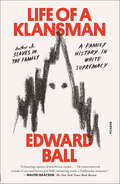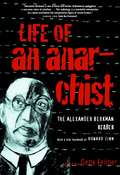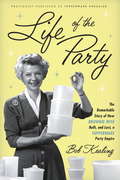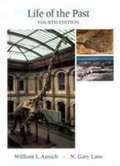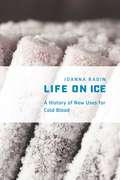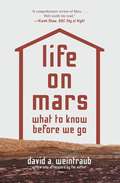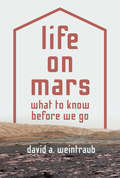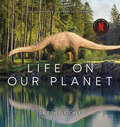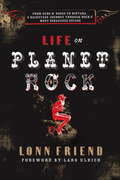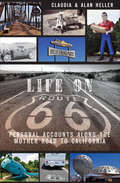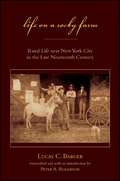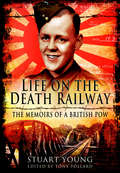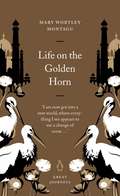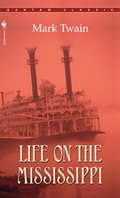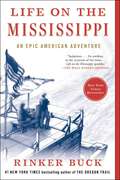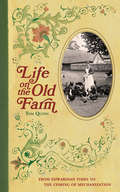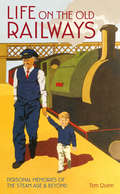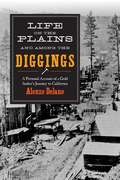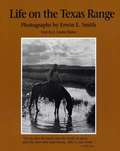- Table View
- List View
Life of a Klansman: A Family History in White Supremacy
by Edward Ball"A haunting tapestry of interwoven stories that inform us not just about our past but about the resentment-bred demons that are all too present in our society today . . . The interconnected strands of race and history give Ball’s entrancing stories a Faulknerian resonance." —Walter Isaacson, The New York Times Book ReviewA 2020 NPR staff pick | One of The New York Times' thirteen books to watch for in August | One of The Washington Post's ten books to read in August | A Literary Hub best book of the summer| One of Kirkus Reviews' sixteen best books to read in AugustThe life and times of a militant white supremacist, written by one of his offspring, National Book Award–winner Edward BallLife of a Klansman tells the story of a warrior in the Ku Klux Klan, a carpenter in Louisiana who took up the cause of fanatical racism during the years after the Civil War. Edward Ball, a descendant of the Klansman, paints a portrait of his family’s anti-black militant that is part history, part memoir rich in personal detail.Sifting through family lore about “our Klansman” as well as public and private records, Ball reconstructs the story of his great-great grandfather, Constant Lecorgne. A white French Creole, father of five, and working class ship carpenter, Lecorgne had a career in white terror of notable and bloody completeness: massacres, night riding, masked marches, street rampages—all part of a tireless effort that he and other Klansmen made to restore white power when it was threatened by the emancipation of four million enslaved African Americans. To offer a non-white view of the Ku-klux, Ball seeks out descendants of African Americans who were once victimized by “our Klansman” and his comrades, and shares their stories.For whites, to have a Klansman in the family tree is no rare thing: Demographic estimates suggest that fifty percent of whites in the United States have at least one ancestor who belonged to the Ku Klux Klan at some point in its history. That is, one-half of white Americans could write a Klan family memoir, if they wished.In an era when racist ideology and violence are again loose in the public square, Life of a Klansman offers a personal origin story of white supremacy. Ball’s family memoir traces the vines that have grown from militant roots in the Old South into the bitter fruit of the present, when whiteness is again a cause that can veer into hate and domestic terror.
Life of a Sailor: By Capt. Frederick Chamier, R. N. (Seafarers' Voices)
by Frederick ChamierChamier was a Royal Navy officer, who like his exact contemporary Captain Marryat is best remembered for a series of naval novels. The Life of a Sailor was his first publication and is usually catalogued as fiction, which may be a tribute to Chamiers story-telling skills but it is wrong the book is an exact account of his naval career, with every personality, ship and event he describes corroborated by his service records. By the time he went to sea in 1809, the heroic age of Nelson was over, but the war was far from won, and he was to see a lot of action, from anti-slavery patrols off Africa to punitive raids on the American coast during the War of 1812.His descriptions of the latter were to prove highly controversial. Like many liberal officers, he deplored the strategy of bringing the war to the civilian population, and the book was much criticised by more senior naval officers for saying so. Chamier represents a new generation of post-Nelsonic naval officer, more gentlemanly, better educated and perhaps more open-minded he certainly got on well with Lord Byron, whom he met in Constantinople and his sympathies generally look forward to the Victorian age. He was too young to rise to high rank, and after the Napoleonic War, like many others, he was condemned to a life on half-pay and perhaps forced into a literary career, but out of it came one of the eras most authentic accounts of a junior officers naval service.
Life of a Slave on a Southern Plantation
by Stephen CurrieThis book describes the lives of slaves on southern plantations, including information on family life, food and housing, work, play, punishment, and escape. Dozens of quotations from plantation owners and visitors, abolitionists, and especially the slaves themselves help bring the period to life for readers.
Life of a Teenager in Wartime London
by Duncan LeatherdaleLife in wartime London evokes images of the Blitz, of air-raid shelters and rationing, of billeted soldiers and evacuated children. These are familiar, collective memories of what life was like in wartime London, yet there remains an often neglected area of our social history: what was life like for teenagers and young people living in London during the Second World War?While children were evacuated and many of their friends and family went to fight, there were many who stayed at home despite the daily threat of air raids and invasion. How did those left behind live, work and play in the nation's capital between 1939 and 1945? Using the diary entries of nineteen-year-old trainee physiotherapist Glennis 'Bunty' Leatherdale, along with other contemporary accounts, Life of a Teenager in Wartime London is a window into the life of a young person finding their way in the world. It shows how young people can cope no matter the dangers they face, be it from bombs or boys, dances or death.
Life of an Anarchist: The Alexander Berkman Reader
by Alexander BerkmanAlexander Berkman was a twentieth-century American revolutionary. Like the abolitionist John Brown before him, Berkman was hugely idealistic, ready to go to the furthest extreme of self-sacrifice and violence on behalf of justice and civil rights. He decided to assassinate industrialist Henry Clay Frick after reading in the newspaper that Pinkertons hired by Frick had opened fire on the Homestead strikers, killing men, women, and children. Berkman's bungled attempt cost him fifteen years in a federal penitentiary. Upon his release, he became an effective agitator against conscription and was again imprisoned and eventually deported to Russia, where he saw at first hand the early days of Bolshevism. Berkman's writings remain a lasting and impassioned record of intense political transformation. Featuring a new introduction by Howard Zinn, Life of an Anarchist contains Prison Memoirs of an Anarchist, Berkman's account of his years in prison; The Bolshevik Myth, his eyewitness account of the early days of the Russian Revolution; and The ABC of Anarchism, the classic text on the nature of anarchism in the twentieth century. Also included are a selection of letters between Berkman and his lifelong companion Emma Goldman, and a generous sampling from Berkman's other publications.
Life of an Enslaved African in the Ottoman Empire and Iran: The Autobiography of Mahboob Qirvanian
by Mahboob QirvanianThe Life of an Enslaved African in the Ottoman Empire and Iran is a poignant and compelling account of one man’s journey through struggle, resilience, and unimaginable suffering. In the early twentieth century, Mahboob Qirvanian recorded his personal experiences of forced migration and enslavement as he navigated his path from captivity in Africa to full citizenship and a reconstructed identity in Iran. Written in Persian and Arabic, this remarkable autobiography serves as a powerful testament to Mahboob’s endurance, suffering, and ultimate transformation.Through insightful analysis, Behnaz A. Mirzai places Mahboob’s narrative – the only known account by a former African slave in Iran – within the context of the political upheavals of the Constitutional Revolution in Iran and the Tanzimat reforms of the Ottoman Empire. This book not only sheds light on Mahboob’s personal story and the historical injustices of slavery but also engages with broader themes of displacement, identity, and social justice. In doing so, it invites readers to reflect on the enduring legacies of racial inequality and the ongoing struggles for freedom and dignity in the modern world.
Life of the Marquess Wellesley
by Col. G. B. MallesonOriginally published in 1895, this newer edition of Colonel Malleson's book chronicling the life of the Richard Cowley Wesley, 1st Marquess Wellesley KG (1760-1842) successfully 'brings out the salient points of character of the great man, indicates his many merits, and makes no attempt to slur over his failings.'Well-received on its first publication, this compact but succinct title makes an important addition to your history collection.
Life of the Party: The Remarkable Story of How Brownie Wise Built, and Lost, a Tupperware Party Empire
by Bob KealingThe incredible story of Brownie Wise, the Southern single mother--and postwar #Girlboss--who built, and lost, a Tupperware home-party empireBefore Mary Kay, Martha Stewart, and Joy Mangano, there was Brownie Wise, the charismatic Tupperware executive who converted postwar optimism into a record-breaking sales engine powered by American housewives. In Life of the Party, Bob Kealing offers the definitive portrait of Wise, a plucky businesswoman who divorced her alcoholic husband, started her own successful business, and eventually caught the eye of Tupperware inventor, Earl Tupper, whose plastic containers were collecting dust on store shelves. The Tupperware Party that Wise popularized, a master-class in the soft sell, drove Tupperware's sales to soaring heights. It also gave minimally educated and economically invisible postwar women, including some African-American women, an acceptable outlet for making their own money for their families--and for being rewarded for their efforts. With the people skills of Dale Carnegie, the looks of Doris Day, and the magnetism of Eva Peron, Wise was as popular among her many devoted followers as she was among the press, and she become the first woman to appear on the cover of BusinessWeek in 1954. Then, at the height of her success, Wise's ascent ended as quickly as it began. Earl Tupper fired her under mysterious circumstances, wrote her out of Tupperware's success story, and left her with a pittance. He walked away with a fortune and she disappeared--until now. Originally published as Tupperware Unsealed by the University Press of Florida in 2008--and optioned by Sony Pictures, with Sandra Bullock attached to star--this revised and updated edition is perfectly timed to take advantage of renewed interest in this long-overlooked American business icon.From the Hardcover edition.
Life of the Past (4th Edition)
by William I. Ausich N. Gary LaneA comprehensive introduction to the history of life on Earth.
Life on Display: Revolutionizing U.S. Museums of Science and Natural History in the Twentieth Century
by Karen A. Rader Victoria E.M. CainRich with archival detail and compelling characters, Life on Display uses the history of biological exhibitions to analyze museums’ shifting roles in twentieth-century American science and society. Karen A. Rader and Victoria E. M. Cain chronicle profound changes in these exhibitions—and the institutions that housed them—between 1910 and 1990, ultimately offering new perspectives on the history of museums, science, and science education. Rader and Cain explain why science and natural history museums began to welcome new audiences between the 1900s and the 1920s and chronicle the turmoil that resulted from the introduction of new kinds of biological displays. They describe how these displays of life changed dramatically once again in the 1930s and 1940s, as museums negotiated changing, often conflicting interests of scientists, educators, and visitors. The authors then reveal how museum staffs, facing intense public and scientific scrutiny, experimented with wildly different definitions of life science and life science education from the 1950s through the 1980s. The book concludes with a discussion of the influence that corporate sponsorship and blockbuster economics wielded over science and natural history museums in the century’s last decades. A vivid, entertaining study of the ways science and natural history museums shaped and were shaped by understandings of science and public education in the twentieth-century United States, Life on Display will appeal to historians, sociologists, and ethnographers of American science and culture, as well as museum practitioners and general readers.
Life on Ice: A History of New Uses for Cold Blood
by Joanna RadinAfter the atomic bombing at the end of World War II, anxieties about survival in the nuclear age led scientists to begin stockpiling and freezing hundreds of thousands of blood samples from indigenous communities around the world. These samples were believed to embody potentially invaluable biological information about genetic ancestry, evolution, microbes, and much more. Today, they persist in freezers as part of a global tissue-based infrastructure. In Life on Ice, Joanna Radin examines how and why these frozen blood samples shaped the practice known as biobanking. The Cold War projects Radin tracks were meant to form an enduring total archive of indigenous blood before it was altered by the polluting forces of modernity. Freezing allowed that blood to act as a time-traveling resource. Radin explores the unique cultural and technical circumstances that created and gave momentum to the phenomenon of life on ice and shows how these preserved blood samples served as the building blocks for biomedicine at the dawn of the genomic age. In an era of vigorous ethical, legal, and cultural debates about genetic privacy and identity, Life on Ice reveals the larger picture—how we got here and the promises and problems involved with finding new uses for cold human blood samples.
Life on Mars: What to Know Before We Go
by David A. WeintraubThe search for life on Mars—and the moral issues confronting us as we prepare to send humans thereDoes life exist on Mars? The question has captivated humans for centuries, but today it has taken on new urgency. As space agencies gear up to send the first manned missions to the Red Planet, we have a responsibility to think deeply about what kinds of life may already dwell there—and whether we have the right to invite ourselves in. Telling the complete story of our ongoing quest to answer one of the most tantalizing questions in astronomy, David Weintraub grapples with the profound moral and ethical questions confronting us as we prepare to introduce an unpredictable new life form—ourselves—into the Martian biosphere. Now with an afterword that discusses the most recent discoveries, Life on Mars explains what we need to know before we go.
Life on Mars: What to Know Before We Go
by David WeintraubThe story of the search for life on Mars—and the moral issues confronting us as we prepare to send humans thereDoes life exist on Mars? The question has captivated humans for centuries, but today it has taken on new urgency. NASA plans to send astronauts to Mars orbit by the 2030s. SpaceX wants to go by 2024, while Mars One wants to land a permanent settlement there in 2032. As we gear up for missions like these, we have a responsibility to think deeply about what kinds of life may already inhabit the planet--and whether we have the right to invite ourselves in. This book tells the complete story of the quest to answer one of the most tantalizing questions in astronomy. But it is more than a history. Life on Mars explains what we need to know before we go.David Weintraub tells why, of all the celestial bodies in our solar system, Mars has beckoned to us the most. He traces how our ideas about life on Mars have been refined by landers and rovers, terrestrial and Mars-orbiting telescopes, spectroscopy, and even a Martian meteorite. He explores how finding DNA-based life on the Red Planet could offer clues about our distant evolutionary past, and grapples with the profound moral and ethical questions confronting us as we prepare to introduce an unpredictable new life form—ourselves—into the Martian biosphere.Life on Mars is also a book about how science is done—and undone—in the age of mass media. It shows how Mars mania has obscured our vision since we first turned our sights on the planet and encourages a healthy skepticism toward the media hype surrounding Mars as humanity prepares to venture forth.
Life on Our Planet: A Stunning Re-examination of Prehistoric Life on Earth
by Tom FletcherAn unforgettable journey into our ancient past, containing powerful lessons to learn about our future.Today there are 20 million species on our planet. Yet what we see is just a snapshot in time. 99% of earth's inhabitants are lost to our deep past. The story of what happened to these lineages—their rise and their fall—is truly remarkable.Accompanying the ground-breaking Netflix series, Life on our Planet uses the latest technology to bring long-extinct creatures back to life. It tells the story of life's epic battle to conquer and survive on Earth, showing in a new light what's been lost to us, and how life's future is now being written by us. From ancient ocean worlds and plant life's first forays onto land, to the rise and fall of the dinosaurs and the devastation of the last Ice Age, this is a sweeping view of evolution, through five extinctions and, with the arrival of humans on earth, the beginning of the sixth...With over 200 photos and images from the series created by the team behind the original Planet Earth series, including remarkable CGI reconstructions, this is an unforgettable journey into our ancient past, containing powerful lessons to learn about our future.
Life on Planet Rock
by Lonn FriendFor fans of heavy metal music, RIP magazine was a cultural touchstone, every bit as crucial in its day as Kerrang, NME or Rolling Stone. Lonn Friend, RIP's legendary editor, helped launch and revive the careers of innumerable acts - including Guns n' Roses, Metallica and Pearl Jam - and created some of the most enduring rock journalism of the decade, rivaling the best work of Lester Bangs and Cameron Crowe. In Life on Planet Rock, Friend describes in lucid and lurid detail how he became the Zelig-like chronicler of the biggest musical moments of the 80s and 90s, providing revealing portraits of artists as varied as Gene Simmons, Alice Cooper, Axl Rose, Jon Bon Jovi, Kurt Cobain, and Steven Tyler, among others. A candid and humorous memoir to appeal to fans of Motley Crue's The Dirt and Seb Hunter's Hell Bent For Leather, Life on Planet Rock is a wormhole back to a fast-moving time in music, filled with Dionysian excess and bombastic egos, told as only someone who was there through it all could tell it.
Life on Route 66: Personal Accounts Along the Mother Road to California
by Alan Heller Claudia HellerA celebration of America&’s most historic highway, in words and pictures. Winding through the rugged heartland of the American West, Route 66 has resonated for generations in hardscrabble tales of hopeful seekers of new homes and new lives. It also inspired Alan and Claudia Heller, longtime residents of Duarte, a California town along Route 66, to hitch their trailer to a retirement dream and travel the road again, journeying through their home state and back to Chicago. They collected stories of the iconic highway, and what it means to the people who live along its way, for a series in the San Gabriel Valley Newspaper Group. This collection retraces their journey and introduces us to some of the people and places that make Route 66 truly historic.
Life on a Rocky Farm: Rural Life near New York City in the Late Nineteenth Century (Excelsior Editions)
by Lucas C. BargerLife on a Rocky Farm couples Lucas C. Barger's (1866–1939) eye for detail with a folksy, anecdotal style to give us a remarkable and memorable depiction of both the traditional ways of farm life, and the challenges the farmers faced as the times changed. Previously unpublished, Barger's first-hand account of farm life near New York City begins in the late nineteenth century. Little had changed for well over a century in the hilly and rugged terrain of Putnam Valley, where Lucas grew up as a member of the sixth generation of Barger farmers. But as the nineteenth century gave way to the twentieth, industrialization and mechanization decreased the demand for farm labor and farmers had to come up with alternate ways to make money.For a long time, supplemental income came from varied means such as beekeeping and using the local forest resources to provide railroad ties, ship timber, and barrel hoops. Wealthy summer boarders from New York City also provided some extra income, but despite the short distance, transportation remained arduous, and population growth did not occur until high improvements were made in the 1930s.Peter A. Rogerson's transcription reflects the flavor of Barger's original writing, as Barger himself said when he was first attempting to publish back in 1939, "I read something along back, that a publisher wrote, and he said, 'Do not change your style.' He claimed the style was sometimes the best part. And I guess that is what you are getting at. If you can call my scribbling a style, and you think it 'odd' use it any way you like. For my main intentions were to write an odd book as I told you once before."
Life on the Death Railway: The Memoirs of a British POW
by Stuart YoungAs a young man Stuart Young endured the horrors of the Japanese prisoner-of-war camps and survived. Later in life, in graphic detail, he recorded the experience the dreadful conditions, the brutal treatment, the sickness and starvation, the merciless routine of forced labour. Yet he also recorded the comradeship among the prisoners, their compassion and strength, and the pastimes and entertainments that helped them to come through an ordeal that is hard to imagine today. First he was held at the notorious Changi camp in Singapore Island, then in the camps in Thailand that accommodated POWs who were forced to work on the Death Railway. Perhaps the most revealing passages of his memoir recall the daily experience of captivity - the ceaseless battle to survive the backbreaking work, the cruelties of the guards and ever-present threat of disease. His account gives a harrowing insight into the daily reality of captivity and it shows why he was determined to document and make sense of what he and his fellow prisoners suffered.
Life on the Golden Horn
by Mary Wortley MontaguTravelling through the wartorn Balkans with her husband on what proved to be a wholly useless diplomatic mission to Constantinople, Mary Wortley Montagu (1689-1762) left a vivid, informative, clever account of her adventures in the mysterious, sophisticated culture of Ottoman palaces, bathing places and courts which - even as her husband's career was falling apart - she could not have enjoyed more.Great Journeys allows readers to travel both around the planet and back through the centuries – but also back into ideas and worlds frightening, ruthless and cruel in different ways from our own. Few reading experiences can begin to match that of engaging with writers who saw astounding things: Great civilisations, walls of ice, violent and implacable jungles, deserts and mountains, multitudes of birds and flowers new to science. Reading these books is to see the world afresh, to rediscover a time when many cultures were quite strange to each other, where legends and stories were treated as facts and in which so much was still to be discovered.
Life on the Mississippi
by Mark TwainFashioned from the same experiences that would inspire the masterpiece Huckleberry Finn, Life on the Mississippi is Mark Twain’s most brilliant and most personal nonfiction work. It is at once an affectionate evocation of the vital river life in the steamboat era and a melancholy reminiscence of its passing after the Civil War, a priceless collection of humorous anecdotes and folktales, and a unique glimpse into Twain’s life before he began to write.Written in a prose style that has been hailed as among the greatest in English literature, Life on the Mississippi established Twain as not only the most popular humorist of his time but also America’s most profound chronicler of the human comedy.
Life on the Mississippi: An Epic American Adventure
by Rinker BuckThe eagerly awaited return of master American storyteller Rinker Buck, Life on the Mississippi is an epic, enchanting blend of history and adventure in which Buck builds a wooden flatboat from the grand “flatboat era” of the 1800s and sails it down the Mississippi River, illuminating the forgotten past of America’s first western frontier. <p><p>Seven years ago, readers around the country fell in love with a singular American voice: Rinker Buck, whose infectious curiosity about history launched him across the West in a covered wagon pulled by mules and propelled his book about the trip, The Oregon Trail, to ten weeks on the New York Times bestseller list. Now, Buck returns to chronicle his latest incredible adventure: building a wooden flatboat from the bygone era of the early 1800s and journeying down the Mississippi River to New Orleans. <p><p>A modern-day Huck Finn, Buck casts off down the river on the flatboat Patience accompanied by an eccentric crew of daring shipmates. Over the course of his voyage, Buck steers his fragile wooden craft through narrow channels dominated by massive cargo barges, rescues his first mate gone overboard, sails blindly through fog, breaks his ribs not once but twice, and camps every night on sandbars, remote islands, and steep levees. As he charts his own journey, he also delivers a richly satisfying work of history that brings to life a lost era. <p><p>The role of the flatboat in our country’s evolution is far more significant than most Americans realize. Between 1800 and 1840, millions of farmers, merchants, and teenage adventurers embarked from states like Pennsylvania and Virginia on flatboats headed beyond the Appalachians to Kentucky, Mississippi, and Louisiana. Like the Nile, the Thames, or the Seine before them, the western rivers in America became a floating supply chain that fueled national growth. Settler families repurposed the wood from their boats to build their first cabins in the wilderness; cargo boats were broken apart and sold to build the boomtowns along the water route. Joining the river traffic were floating brothels, called “gun boats”; “smithy boats” for blacksmiths; even “whiskey boats” with taverns mounted on jaunty rafts. In the present day, America’s inland rivers are a superhighway dominated by leviathan barges—carrying $80 billion of cargo annually—all descended from flatboats like the ramshackle Patience, which must avoid being crushed alongside their metal hulls. <p><p>As a historian, Buck resurrects the era’s adventurous spirit, but he also challenges familiar myths about American expansion, confronting the bloody truth behind settlers’ push for land and wealth. The Indian Removal Act of 1830 forced more than 125,000 members of the Cherokee, Choctaw, and several other tribes to travel the Mississippi on a brutal journey en route to the barrens of Oklahoma. Simultaneously, almost a million enslaved African Americans were carried in flatboats and marched by foot 1,000 miles over the Appalachians to the cotton and cane fields of Arkansas, Mississippi, and Louisiana, birthing the term “sold down the river.” Weaving together a tapestry of first-person histories, Buck portrays this watershed era of American expansion as it was really lived. <p><p>With a rare narrative power that blends stirring adventure with absorbing untold history, Life on the Mississippi is a muscular and majestic feat of storytelling from a writer who may be the closest that we have today to Mark Twain. <p> <b>New York Times Bestseller</b>
Life on the Old Farm: From Edwardian Times to the Coming of Mechanization
by Tom Quinn"Life on the Old Farm takes you back to a time, not so long ago, when country life in Britain followed a pattern that had remained largely unchanged for centuries. In this series of fascinating reminiscences, farmers from all over Britain reveal their knowledge - the last generation who know at first hand traditions dating back to Saxon times. Life on the Old Farm is nostalgic and informative with fascinating interviews and insights into how things used to be done. It covers a time span from before Edwardian times up to the coming of mechanization after World War II. "
Life on the Old Railways: Personal Memories Of The Steam Age And Beyond
by Tom QuinnTake a step back into the world of steam railways, and discover the reality of life and work on Britain's railway system before the Beeching cuts and the introduction of diesel changed it forever. Tom Quinn has sought out a fascinating range of characters who recount their experiences of working on steam trains. From a shedmaster to a fireman, from an engine driver to a signalman, tales of accidents and mishaps, evenings round the fire in the worker's common room and the perils of left luggage in the days when almost anything might - and frequently did - turn up! Remarkable reminiscences about life on the old railways when Britain's railway system was the envy of the world.
Life on the Plains and among the Diggings: A Personal Account of a Gold Seeker?s Journey to California
by Alonzo DelanoDuring the California gold rush, 300,000 prospectors flocked to California in the hopes of making it rich. Among them was Alonzo Delano, who set out alone at the age of forty-two, leaving his family behind in Illinois, both to seek out new opportunity and because of a doctor’s prescription for a western climate to help cure a lung ailment. He was, in his words, both seized by a "fever of the body” as well as a "fever of mind for gold,” and his hope was to cure both. Unlike many of the other gold rushers, Delano was a highly observant and literate man, and he wrote frequent correspondence back home that later became the book Life on the Plains and among the Diggings. In it, Delano recounts the incredible adventure to California, one that was filled with humor and equal parts unrivaled optimism and crushing tragedy; not all of the hopeful prospectors survived the journey. With keen, true-to-life observations and an eye for detail, Delano describes the trek past the northern plains, through the Wyoming wilderness, across the brutal Nevada Black Rock Desert, and finally into the promised land of California. He goes on to recount how he settles into a new life, becoming an influential writer. Life on the Plains and among the Diggings is an amazing, true story of adventure and a fascinating look at the brave pioneers who made America what it is today. Skyhorse Publishing, as well as our Arcade imprint, are proud to publish a broad range of books for readers interested in history--books about World War II, the Third Reich, Hitler and his henchmen, the JFK assassination, conspiracies, the American Civil War, the American Revolution, gladiators, Vikings, ancient Rome, medieval times, the old West, and much more. While not every title we publish becomes a New York Times bestseller or a national bestseller, we are committed to books on subjects that are sometimes overlooked and to authors whose work might not otherwise find a home.
Life on the Texas Range
by Erwin E. Smith J. Evetts HaleyFirst published in 1953, this photographic record of the real life and work of cowboys remains a perennial favorite. Erwin E. Smith was the outstanding cowboy photographer of the West, and these eighty photographs were among those he chose for an exhibit of his best work at the 1936 Texas Centennial. The text by J. Evetts Haley, a noted historian of the range, skillfully complements Smith's visual record of a vanishing way of life.
